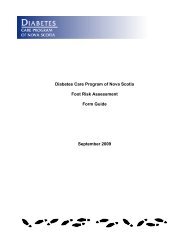Caregiver Support and Well-Being Priority Project - Central East ...
Caregiver Support and Well-Being Priority Project - Central East ...
Caregiver Support and Well-Being Priority Project - Central East ...
Create successful ePaper yourself
Turn your PDF publications into a flip-book with our unique Google optimized e-Paper software.
• <strong>Caregiver</strong>s provide the invisible back-up that allows the heath care system to keep functioningdespite limited public resources. <strong>Caregiver</strong>s make the shift away from institutionalized care possible.Despite these realities, the health system has been woefully inadequate in its recognition <strong>and</strong> supportof family caregivers across Canada. xxv• A shift away from institutionalizing has left the bulk of care giving for seniors <strong>and</strong> individuals withmental health or addiction conditions <strong>and</strong> chronic diseases to family members <strong>and</strong> friends xxvi xxvii ; inmany cases, the presence <strong>and</strong> commitment of these caregivers makes an important difference inincreasing the possibility that care receivers can stay in their homes. xxviii• <strong>Caregiver</strong>s’ needs, networks, resources, strengths <strong>and</strong> limitations vary from caregiver to caregiver xxix ;caregivers of different ethnic groups may experience the caregiver role differently, due, in part, todifferent perceptions of family <strong>and</strong> family obligations as well as to differences in social supports <strong>and</strong>the personal coping capacities of the caregivers.• Much of the current volunteering capacity is made up of today’s seniors. We must consider what willhappen when those seniors are in need of care themselves. xxx• Individuals providing four hours or more of care per week were more likely to reduce their work hours,change their work patterns or turn down a job offer or promotion. Among this group, 65% of women<strong>and</strong> 47% of men who were working over 40 hours per week were substantially affected. xxxi• Most are providing care to someone with a physical disability with 1 in 5 having both physical <strong>and</strong>mental difficulties xxxii ; the majority of people with disabilities who need support are supported entirelyby their family members <strong>and</strong> friends. xxxiii• Approximately 50% of individuals with dementia in Canada live in the community <strong>and</strong> almost all ofthese individuals are cared for by family or friends until these caregivers are no longer able tomaintain them at home. xxxiv• Individuals providing care to a family member are most likely to feel stressed in terms of theiremotional health, with close to 80% of individuals providing care to a family member reporting someemotional difficulties for themselves? xxxv Many require the use of mental health services <strong>and</strong>medication for their own problems. xxxvi<strong>Project</strong> CharterAt the 2007 <strong>Central</strong> <strong>East</strong> LHIN symposium entitled, “From Planning to Action”, planning partnersprioritized a list of projects from the Integrated Health Service Plan. Participants identified that caregivers’health <strong>and</strong> well being was one of the priorities which needed to move forward; in fact, it was priority #1.In December 2007, the <strong>Central</strong> <strong>East</strong> LHIN Board of Directors approved the <strong>Caregiver</strong> <strong>Support</strong> <strong>and</strong> <strong>Well</strong><strong>Being</strong> <strong>Priority</strong> <strong>Project</strong> along with a number of other projects which were aligned to the <strong>Central</strong> <strong>East</strong>LHIN’s strategic directions. The <strong>Caregiver</strong> <strong>Support</strong> <strong>and</strong> <strong>Well</strong> <strong>Being</strong> <strong>Priority</strong> <strong>Project</strong> was sponsored by theDurham <strong>East</strong> Collaborative <strong>and</strong> a project charter writing team was developed from that collaborative <strong>and</strong>from other interested community members.The project charter (Appendix 2) outlines the scope, objectives <strong>and</strong> participants in the project <strong>and</strong>provided a valuable reference base for the development <strong>and</strong> completion of the project.The <strong>Caregiver</strong> <strong>Support</strong> <strong>and</strong> <strong>Well</strong> <strong>Being</strong> <strong>Priority</strong> <strong>Project</strong> was funded from the Year One Aging at Home(AAH) strategy. The AAH Strategy is a three year strategy aimed at reviewing <strong>and</strong> revising the wayservices are delivered to seniors <strong>and</strong> providing more equitable access to health care for seniors.With each year of the strategy, funding has been allocated for community support services to enhanceservices for caregivers (Appendix 3).In March 2008, a project coordinator was hired <strong>and</strong> a project team was formed. The 18-member projectteam consisted of seven caregivers <strong>and</strong> 11 individuals representing organizations in the <strong>Central</strong> <strong>East</strong>LHIN that provide support for caregivers.9
















